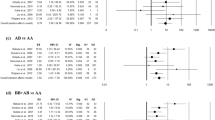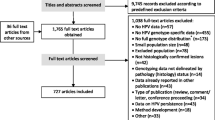Abstract
The innate immune responses at mucosal surfaces of the lower female genital tract play a central role in preventing the establishment of infection. Variability in the genes regulating innate immune recognition or response to infectious microorganisms could explain interindividual differences in susceptibility to infection and severity of infectious disorders. Of the numerous genetic variations identified within immunoregulatory genes, only a few have so far been studied in relation to infectious disorders of the lower female genital tract. Although these studies broaden our understanding of the genetic influence on mucosal innate immunity and microbiologic outcome, they also highlight the complexity of links between genotypical and phenotypical features, ie, the influence of a single genetic marker on the phenotype is at best moderate and is not constant in every ethnic/ racial group. Such inconsistency is primarily attributed to gene-to-gene interactions and demographic genetic variability. Large case-control studies evaluating multiple genetic markers simultaneously in well-defined subgroups will characterize patients more accurately and pave the way to personalized medicine.
Similar content being viewed by others
References and Recommended Reading
Genç MR, Witkin SS, Delaney ML, et al.: A disproportionate increase in IL-b over IL-1ra in the cervicovaginal secretions of pregnant women with vaginal infection correlates with preterm birth. Am J Obstet Gynecol 2004, 190:1191–1197. This is a good example for studying the interaction between vaginal organisms and innate immunity.
Rasmussen SJ, Eckmann L, Quayle AJ, et al.: Secretion of proinflammatory cytokines by epithelial cells in response to Chlamydia infection suggests a central role for epithelial cells in chlamydial pathogenesis. J Clin Invest 1997, 99:77–87.
Fichorova RN, Desai PJ, Gibson FC, Genco CA: Distinct proinflammatory host responses to Neisseria gonorrhoeae infection in immortalized human cervical and vaginal epithelial cells. Infect Immun 2001, 69:5840–5848.
Romero R, Mazor M, Brandt F, et al.: Interleukin-1 alpha and interleukin-1 beta in preterm and term human parturition. Am J Reprod Immunol 1992, 27:117–123.
Romero R, Sepulveda W, Mazor M, et al.: The natural interleukin-1 receptor antagonist in term and preterm parturition. Am J Obstet Gynecol 1992, 167:863–872.
Leslie KK, Lee SL, Woodcock SM, et al.: Acute intrauterine infection results in an imbalance between pro- and antiinflammatory cytokines in the pregnant rabbit. Am J Reprod Immunol 2000, 43:305–311.
Romero R, Tartakovsky B: The natural interleukin-1 receptor antagonist prevents interleukin-1-induced preterm delivery in mice. Am J Obstet Gynecol 1992, 167:1041–1045.
Witkin S, Gravett M, Haluska G, Novy M: Induction of interleukin-1 receptor antagonist in rhesus monkeys after intraamniotic infection with group B streptococci or interleukin-1 infusion. Am J Obstet Gynecol 1994, 171:1668–1672.
Hurme M, Lahdenpohja N, Santtila S: Gene polymorphisms of interleukins 1 and 10 in infectious and autoimmune diseases. Ann Med 1998, 30:469–473.
Nguyen DP, Genc M, Vardhana S, et al.: Ethnic differences of polymorphisms in cytokine and innate immune system genes in pregnant women. Obstet Gynecol 2004, 104:293–300. This is an important study.
Danis VA, Millington M, Hyland VJ, Grennan D: Cytokine production by normal human monocytes: inter-subject variation and relationship to an IL-1 receptor antagonist (IL-1Ra) gene polymorphism. Clin Exp Immunol 1995, 99:303–310.
Vamvakopoulos J, Green C, Metcalfe S: Genetic control of IL-1beta bioactivity through differential regulation of the IL-1 receptor antagonist. Eur J Immunol 2002, 32:2988–2996.
Hurme M, Santtila S: IL-1 receptor antagonist (IL-1Ra) plasma levels are coordinately regulated by both IL-1Ra and IL-1beta genes. Eur J Immunol 1998, 28:2598–2602. This is an important study.
Tountas NA, Casini-Raggi V, Yang H: Functional and ethnic association of allele 2 of the interleukin-1 receptor antagonist gene in ulcerative colitis. Gastroenterology 1999, 117:806–813.
Andus T, Daig R, Vogl D, et al.: Imbalance of the interleukin 1 system in colonic mucosa: association with intestinal inflammation and interleukin 1 receptor antagonist genotype 2. Gut 1997, 41:651–657.
Santtila S, Savinainen K, Hurme M: Presence of the IL-1RA allele 2 (IL1RN*2) is associated with enhanced IL-1beta production in vitro. Scand J Immunol 1998, 47:195–198.
El-Omar EM, Carrington M, Chow W-H, et al.: Interleukin-1 polymorphisms associated with increased risk of gastric cancer. Nature 2000, 404:398–402.
Hall SK, Perregaux DG, Gabel CA, et al.: Correlation of polymorphic variation in the promoter region of the interleukin-1 beta gene with secretion of interleukin-1 beta protein. Arthritis Rheum 2004, 50:1976–1983.
Genç MR, Onderdonk AB, Vardhana S, et al.: Polymorphism in intron 2 of interleukin 1 receptor antagonist gene, abnormal vaginal microflora in midtrimester and preterm delivery. Am J Obstet Gynecol 2004, In press. This is a unique study investigating the influence of gene variability on innate immunity to vaginal organisms.
Barton PT, Gerber S, Skupski DW, Witkin SS: Interleukin-1 receptor antagonist gene polymorphism, vaginal interleukin-1 receptor antagonist concentrations, and vaginal Ureaplasma urealyticum colonization in pregnant women. Infect Immun 2003, 71:271–274. This is an important study.
Foster DC, Hasday JD: Elevated tissue levels of interleukin-1 beta and tumor necrosis factor-alpha in vulvar vestibulitis. Obstet Gynecol 1997, 89:291–296.
Jeremias J, Ledger W, Witkin SS: Interleukin 1 receptor antagonist gene polymorphism in women with vulvar vestibulitis. Am J Obstet Gynecol 1999, 182:283–285. This is an important study.
Hajeer A, Hutchinson I: TNF-alpha gene polymorphism: clinical and biological implications. Micros Res Tech 2000, 50:216–228.
Prebeck S, Brade H, Kirschning CJ, et al.: The Gram-negative bacterium Chlamydia trachomatis L2 stimulates tumor necrosis factor secretion by innate immune cells independently of its endotoxin. Microbes Infect 2003, 5:463–470.
Zariffard MR, Harwani S, Novak RM, et al.: Trichomonas vaginalis infection activates cells through toll-like receptor 4. Clin Immunol 2004, 111:103–107.
Sturm-Ramirez K, Gaye-Diallo A, Eisen G, et al.: High levels of tumor necrosis factor-alpha and interleukin-1beta in bacterial vaginosis may increase susceptibility to human immunodeficiency virus. J Infect Dis 2000, 182:467–473.
Imseis HM, Greig PC, Livengood CH, et al.: Characterization of the inflammatory cytokines in the vagina during pregnancy and labor and with bacterial vaginosis. J Soc Gynecol Investig 1997, 4:90–94.
Mattsby-Baltzer I, Platz-Christensen JJ, Hosseini N, Rosen P: IL-1beta, IL-6, TNF alpha, fetal fibronectin, and endotoxin in the lower genital tract of pregnant women with bacterial vaginosis. Obstet Gynecol Scand 1998, 77:701–706.
Taha TE, Hoover DR, Dallabetta GA, et al.: Bacterial vaginosis and disturbances of vaginal flora: association with increased acquisition of HIV. AIDS 1998, 12:1699–1706.
Martin HL, Richardson BA, Nyange PM, et al.: Vaginal lactobacilli, microbial flora, and risk of human immunodeficiency virus type 1 and sexually transmitted disease acquisition. J Infect Dis 1999, 180:1863–1868.
Clerici M, Merola M, Ferrario E, et al.: Cytokine production patterns in cervical intraepithelial neoplasia: association with human papillomavirus infection. J Natl Cancer Inst 1997, 89:245–250.
Tartour E, Gey A, Sastsre-Garou X, et al.: Prognostic value of intratumoral interferon gamma messenger RNA expression in invasive cervical carcinomas. J Natl Cancer Inst 1998, 90:287–294.
Tartour E, Pannetier C, Mathiot C, et al.: Prognostic value of cytokine and Fc gamma receptor assays in oncology. Immunol Lett 1995, 44:145–148.
Kirkpatrick A, Bidwell J, van den Brule AJ, et al.: TNF alpha polymorphism frequencies in HPV-associated cervical dysplasia. Gynecol Oncol 2004, 92:675–679. This is an important study.
Abreu MT, Arditi M: Innate immunity and toll-like receptors: clinical implications of basic science research. J Pediatr 2004, 144:421–429.
Arbour NC, Lorenz E, Schutte BC, et al.: TLR4 mutations are associated with endotoxin hyporesponsiveness in humans. Nat Genet 2000, 25:187–191.
Schwartz DA: The genetics of innate immunity. Chest 2002, 121:62S-68S.
Erridge C, Stewart J, Poxton IR: Monocytes heterozygous for the Asp299Gly and Thr399Ile mutations in the Toll-like receptor 4 gene show no deficit in lipopolysaccharide signalling. J Exp Med 2003, 197:1787–1791.
Genc MR, Vardhana S, Onderdonk A, et al.: Relationship between a toll-like receptor-4 gene polymorphism and cytokine response to vaginal microorganisms in pregnant women. Eur J Obstet Gynecol Reprod Biol 2004, 116:152–156. This is an important study.
Fichorova RN, Cronin AO, Lien E, et al.: Response to Neisseria gonorrhoeae by cervicovaginal epithelial cells occurs in the absence of toll-like receptor 4-mediated signaling. J Immunol 2002, 168:2424–2432.
Darville T, O’Neill JM, Andrews CW Jr, et al.: Toll-like receptor-2, but not Toll-like receptor-4, is essential for development of oviduct pathology in chlamydial genital tract infection. J Immunol 2003, 171:6187–6197.
Netea MG, Van Der Graaf CA, Vonk AG, et al.: The role of tolllike receptor (TLR) 2 and TLR4 in the host defense against disseminated candidiasis. J Infect Dis 2002, 185:1483–1489.
Morre SA, Murillo LS, Bruggeman CA, Pena AS: The role that the functional Asp299Gly polymorphism in the toll-like receptor-4 gene plays in susceptibility to Chlamydia trachomatis-associated tubal infertility. J Infect Dis 2003, 187:341–342. This is an important study.
Morre SA, Murillo LS, Spaargaren J, et al.: Role of the toll-like receptor 4 Asp299Gly polymorphism in susceptibility to Candida albicans infection. J Infect Dis 2002, 186:1377–1379. This is an important study.
Babovic-Vuksanovic D, Snow K, Ten RM: Mannose-binding lectin (MBL) deficiency. Variant alleles in a Midwestern population of the United States. Ann Allergy Asthma Immunol 1999, 82:134–143.
Babula O, Lazdane G, Kroica J, et al.: Relation between recurrent vulvovaginal candidiasis, vaginal concentrations of mannosebinding lectin, and a mannose-binding lectin gene polymorphism in Latvian women. Clin Infect Dis 2003, 37:733–737. This is an important study.
Wu C: Heat shock transcription factors: structure and regulation. Annu Rev Cell Dev Biol 1995, 11:441–469.
Cahill CM, Waterman WR, Xie Y, et al.: Transcriptional repression of the prointerleukin 1beta gene by heat shock factor 1. J Biol Chem 1996, 271:24874–24879.
Asea A, Kraeft SK, Kurt-Jones EA, et al.: Hsp70 stimulates cytokine production through a CD14-dependent pathway, demonstrating its dual role as a chaperone and cytokine. Nature Med 2000, 6:435–442.
Asea A, Rehl M, Kabingu E, et al.: Novel signal transduction pathway utilized by extracellular hsp70. Role of toll-like receptor (TLR) 2 and TLR4. J Biol Chem 2002, 277:15028–15034.
Milner CM, Campbell RD: Structure and expression of the three MHC-linked HSP70 genes. Immunogenetics 1990, 32:242–251.
Goldenberg RL, Klebanoff MA, Nugent R, et al.: Bacterial colonization of the vagina during pregnancy in four ethnic groups. Vaginal Infections and Prematurity Study Group. Am J Obstet Gynecol 1996, 174:1618–1621.
Royce RA, Jackson TP, Thorp JM, et al.: Race/ethnicity, vaginal flora patterns, and pH during pregnancy. Sex Transm Dis 1999, 26:96–102.
Stevens-Simon C, Jamison J, McGregor JA, Douglas JM: Racial variation in vaginal pH among healthy sexually active adolescents. Sex Transm Dis 1994, 21:168–172.
Author information
Authors and Affiliations
Rights and permissions
About this article
Cite this article
Genç, M.R., Onderdonk, A. & Witkin, S.S. Innate immune system gene polymorphisms in women with vulvovaginal infections. Curr Infect Dis Rep 6, 462–468 (2004). https://doi.org/10.1007/s11908-004-0066-6
Issue Date:
DOI: https://doi.org/10.1007/s11908-004-0066-6




